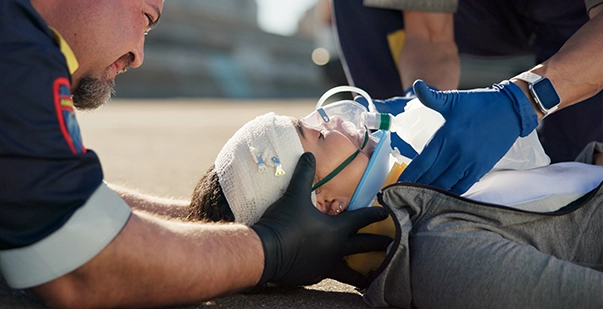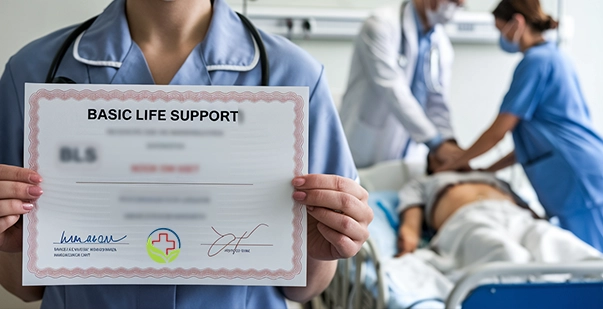The career as a paramedic is challenging yet fulfilling, impactful, and rewarding. A paramedic is an expert medical person who gives first aid to patients suffering from sudden life-threatening conditions. After arriving at the scene of an emergency, they provide immediate treatment to the patient and supervise medical emergencies before reaching the hospital.
Emergency Medical Services handles over 27 million emergency treatment requests each year. Hence, paramedics play an invaluable role in healthcare by managing the most difficult situations. To serve in healthcare, several people aspire to become paramedics but lack knowledge about how to become a paramedic. Besides a deep compassion and a desire to serve, an aspiring paramedic needs to meet several other criteria to achieve this role. This guide covers all you need to learn how do you become a paramedic and when seeking a profession in paramedical services
Understand the Job Role and Duties of a Paramedic
Medical emergencies often take the form of injuries, heavy bleeding, heart attacks, shock, and other threatening symptoms. Such medical emergencies need a professional trained in stabilizing patients. Someone who can provide immediate medical care before reaching the hospital. These are the tasks paramedics specialize in.
To understand the paramedical career better, you must know what paramedics do. A paramedic is accountable for handling the following tasks:
- As first responders to an accident, they respond to emergencies by assessing the state of patients.
- They determine the severity of injuries or illnesses during a medical emergency by assessing heart rate and blood pressure and conducting a physical examination if necessary.
- Once the patient has been evaluated, basic healthcare services are provided to prevent the situation from worsening. These include, but are not limited to, administering CPR, controlling bleeding, providing medication, or using defibrillators.
- Paramedics are expected to inform and prepare hospital emergency department staff about the critical situation. They also monitor patients’ conditions and inform hospital personnel. They are also in charge of safely moving patients to the hospital.
ER Nurse vs. EMT vs. Paramedic: What’s the Difference?
Several people get confused between ER nurses, EMT professionals, and paramedics due to their similar duties. Since all three professionals handle critical situations, the confusion raises the question: What is a paramedic?
These three professions differ in training, scope of practice, and work environments. Below is the insight into the role of ER nurse, EMT, and paramedic in healthcare:
- ER Nurse:
The emergency room nurses work in the hospital setting, specifically in the emergency department. For this role, they complete a nursing program and pass the NCLEX-RN licensing exam. They provide care for patients who arrive at the hospital with various emergencies, from minor to severe. They also manage many patients at once, making multitasking a key skill.
- EMT:
The Emergency Medical Technician provides basic life support (BLS) at the scene of an emergency. Since they perform basic healthcare tasks, they are trained for a shorter duration than a paramedic. Their tasks involve performing CPR, controlling bleeding, providing oxygen, responding to 911 calls, and transporting patients via ambulance.
- Paramedic:
Though paramedics perform duties similar to an EMT, they are more advanced. They can also provide advanced life support (ALS). Besides basic life support, the other tasks they perform when needed include administering medications, starting IVs, performing advanced airway management, and using complex equipment like electrocardiograms (EKGs). Unlike ER nurses, both EMTs and paramedics work in pre-hospital settings.
Read more: How to Become an Emergency Medical Technician (EMT)
What is the Duration Required to Become a Paramedic?
Once you have decided to pursue paramedics, the question is how long does it take to become a paramedic. The answer depends on several factors, such as the time you can invest in training, whether you opt for part-time or full-time courses, paramedic exam results, etc. Usually, it takes 1.5 to 3 years, including the duration of EMT training, CPR certification, and Paramedic program. Below are the key aspects of the paramedic journey:
- EMT Training: Possession of an EMT certificate is a prerequisite for advanced paramedic training. This basic medical support training typically comprises 3-6 month certificate programs.
- Paramedic Training: After EMT’s basic training, you can enroll in a paramedic program. The paramedic program involves an advanced curriculum. It emphasizes comprehensive medical training to handle emergencies. Hence, it involves a 1 to 2 year-long training program.
- Certification and Licensing: After training, you need to pass the paramedic exam. The exam for aspiring paramedics is the National Registry of Emergency Medical Technicians (NREMT). Passing this exam qualifies you for the state license. The exam and licensing process can further take a few months.
6 Steps to Become a Paramedic
Paramedic is a highly in-demand profession with impressive prospects, projected to grow 11% by 2030. The journey to become a paramedic is a long process involving several steps. The six essential steps involved in the path to becoming a paramedic are listed below:
- Meet Basic Eligibility Criteria
Before the training and exam criteria, you need to meet the basic eligibility requirements. The minimum age for the basic training program is 18. Besides, have a high school diploma or equivalent (such as a GED or a course in biology, anatomy, and physiology). It is imperative to pass a physical examination, undergo drug testing, and clear a background screening.
- Attain CPR and EMT Training
CPR is the most essential and basic skill a paramedic should have. Thus, the aspiring paramedic should be certified in CPR. Besides CPR, other skills like handling excessive bleeding or using AED devices are taught during EMT training. The training for emergency medical technicians includes 120-150 hours of coursework. It makes one eligible for a paramedic program, covering skills like patient assessment, managing cardiac emergencies, and handling trauma.
- Enroll in a Paramedic Program
After EMT certification, you need paramedic training certification. This training comprises 1-2 years of coursework and offers advanced training in intubation, defibrillation, pharmacology, and intravenous (IV) therapy.
Besides theoretical and practical coursework, paramedic training involves field internships for work experience. Gain some work experience as an EMT before enrolling in a paramedic program. This strengthens your skills and knowledge and ensures the best work opportunities.
4. Pass the National Exam for Licensing
When you are done with training and certification, the state tests your training. Completing the course doesn’t ensure you get the license to work as a paramedic, but the NREMT exam does. Divided into a cognitive (written) test and a psychomotor (practical skills) test, it tests your knowledge and practical skills. For the exam, you have to register on NREMT’s official site and pay the registration fees.
5. Obtain a State License
Obtaining a license is essential to practice as a paramedic. You can find the needed details about paramedic licensing through your state’s EMS office. Attaining a state license includes the following eligibility requirements:
- To qualify, your minimum age should be eighteen.
- A high school diploma or a GED is a mandatory qualification.
- You should have a valid and up-to-date EMT and CPR certification.
- You must graduate from an accredited paramedic program.
- You must pass the written and practical test of the NREMT Paramedic Exam.
After meeting all these requirements, you can apply for licensure in your state. For the same, you have to submit your exam results, proof of completed training, and qualify background check. Once you get the license, you’ll need to renew your certification periodically every two to three years to stay licensed.
6. Explore work opportunities.
The career opportunities are vast in paramedical services. Emergency healthcare providers are sought-after in various industries. After receiving training and obtaining a license, you can choose a paramedic profession in any of the following fields:
- Ambulance services
- Fire Departments
- Hospital’s emergency department
- Corporate settings like oil rigs or large public events.
You can also pursue specialized certifications in critical care or flight paramedicine. The emergency medical specializations help you get promising roles as a paramedic instructor, EMS coordinator, and even a nurse or physician assistant.
Read more: CPR Training Requirements for Healthcare Providers
Paramedic Training Program Curriculum
The paramedic training involves a rigorous curriculum. It equips students with the knowledge, skills, and hands-on experience essential for advanced emergency medical care. It spans over 1,600 hours and can be completed within 12 to 24 months. The paramedic program curriculum comprises the following key aspects:
- Instructive Coursework:
This training includes the theoretical foundations of emergency medicine. It provides extensive knowledge of the human body systems. Physiology knowledge is essential to understanding how illnesses and injuries affect body parts. It also equips students with airway management techniques and an understanding of heart conditions. Hence, the theoretical curriculum covers the following topics:
- Anatomy and Physiology
- Pharmacology
- Advanced Airway Management
- Cardiology
- Medical emergencies like strokes and seizures.
- Trauma Care
- Pediatrics and Geriatrics
- Hand-on Experience:
The coursework also involves practical training in lab skills. The professional must know how to insert tubes into patients’ airways or tackle IV illness. The following areas are the emphasis of the project-driven practical training:
- Intravenous (IV) Therapy
- Intubation
- Patient Assessment
- Clinical Experience:
Besides attaining practical training through specific projects, the students also gain real-world experience. They have to work in departments like the emergency room, intensive care unit (ICU), and labor and delivery during clinical rotations.
During practical training, they also work with ambulances. Hands-on experience strengthens their abilities, making them capable of handling emergencies in high-stress conditions.
Tips to Clear the NREMT Paramedic Exam
Your study routine and exam practice significantly influence your pursuit of becoming a paramedic. If you pass NREMT with impressive grades, you can get desirable work opportunities. Some tips to help you prepare for NREMT exams include:
- Set a fixed time for study by splitting it into sections that are not too exhausting.
- Concentrate more on anatomy, physiology, pharmacology, cardiology, and emergency medicine.
- Use practice tests because they make you familiar with the format of the questions. Additionally, assessments enable learners to identify weak points.
- Regularly practice your skills, focusing on intubation, IV insertion, and patient evaluation. Practical training develops muscle memory and self-assurance.
- Collaborate with peers to gain different insights into related topics.
While preparing for exams, you must sleep well, eat a healthy diet, and relieve stress. To succeed, it is important to be clear-headed and fit. On the test day, remain composed and have faith in your preparation.
Final Words
In life-threatening scenarios, paramedics hold an important position as they help save lives and improve patients’ conditions immensely. The healthcare industry values paramedics for their quick decision-making, wide-ranging medical knowledge, and skills to act when under pressure. In fact, it is projected that there will be a gradual increase in demand for paramedics because of the rising aging population.
Apart from this, the unending need for emergency health services also contributes to this demand. New job opportunities and career paths may arise from the expansion of paramedical services due to the development of new medical technologies. Thus, if you know how to become a paramedic and follow the guide with strong determination, you can have a successful career as a paramedic.










